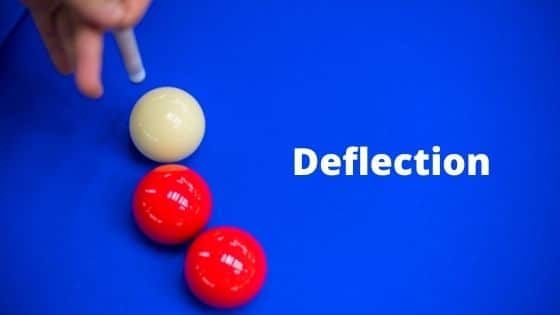Deciding to change to a low deflection shaft can have a major impact on your game. Some things will be good and some not so good. I just believe that it’s not something to take lightly especially if you have been paying pool for a few years and have grooved in your cue action.
How does a low deflection shaft work?
A low deflection shaft is designed to reduce the amount of cue ball deflection, or spin, that is caused by the cue tip contacting the cue ball. Low deflection shafts can come in a variety of materials, ranging from wood to carbon fiber and are designed to increase shot accuracy and consistency.
Why Look at low Deflection Pool Cue Shafts LD?
Firstly, when I came back to playing pool after my break I was amazed to see the number of low deflection shafts and in particular carbon fiber shafts that were being used.
This was not just top players and professionals but across the board adaptation of the new technology.
Local league player were shelling out hundreds of dollars on new equipment.
Secondly, I was playing with a 30 year old Mcdermott cue which had a very slim shaft. Being a snooker player I was attracted to the small tip size because it felt familiar and comfortable although not ideal for American pool.
This shaft was making a strange pinging noise on impact with the cue ball, a fact not missed by other players who pointed out this strange metallic click.
My Decision was therefore made easier …. I needed a new cue anyway, so why not get one of those new low deflection carbon shafts that everyone was using these days?
Great idea Rob, what could possibly be wrong with that logic?
My Main Problem With Low Deflection Cues.
Before I get into it let me just say this:
- If you are reading this article and you don’t know what deflection is…….
- If you don’t know what a low deflection cue shaft is……..
- If you have just started to play pool……
…. its a pretty safe bet that you should just go out and buy one.
Do I recommend a LD shaft for beginner players? Yes.
WHY ……because you have nothing to lose and a great deal to gain from starting off your journey with the latest technology.
LD shafts do make some aspects of the game easier to learn Quickly.
Having said that, I have been playing cue sports for a long time. If you have been using a standard shaft for a few years it can be a very difficult transition because:
- I understand deflection.
- I use deflection to my advantage.
- My muscle memory is full of shot examples.
- Deflection is an integral part of my game.
Switching to low deflection equipment at this point in my playing career will be difficult, not impossible, but definitely not without a substantial investment of time and effort.
Why Is Deflection A Problem With a Regular Shaft?
Deflection is the amount of cue ball movement away from the aim line experienced when striking the ball with an off center cue tip position.
When striking the white ball left of center, the white initially is pushed out to the right and vice versa.
The amount of deflection experienced is a multi-variable, it depends on many factors including:
- Distance.
- Shot speed.
- Stroke.
- Ball swerve.
- Vertical Spin.
- Type of cloth.
- Thickness of Contact.
- Humidity
What’s The Problem With Carbon Fiber LD Shaft?
The shafts are made from a different material.
The shaft itself tends to be black or maybe even dark grey.
Some shafts have no ferrule at all, some shafts have a small white ferrule.
The shafts tend to be very light. (Low end mass.)
Some of them just don’t sound right having a metallic pinging sound on impact.
All shafts are different but most importantly they are all very different to the one that you have been using.
Practicing With A New Predator Carbon Fiber Shaft.
So I bought this low deflection shaft with a 5/16″ x 14 joint that would fit onto my existing cue butt.
I had the tip changed to a Kamui medium. I had been using Kamui tips for a while and felt comfortable playing with them.
On the practice table I started of with some long straight in shots, alternating follow, stun and draw.
The shaft sounded kind of hollow but the ball were going into the pocket.
I continued for a while concentrating on center ball striking, follow through and staying down on the shot.
Next I set up a series of shots that I regularly play with a small amount of sidespin, half to a full tip, slow to medium pace. These shots were nothing fancy just straightening out the cue ball for shape off a rail.
I needed to make less of an allowance for deflection than with my playing cue.
So far so good, it felt strange but I could get used to the shaft given enough time.
Using A New Low-Deflection Shaft?
That depends on what you are looking for, doesn’t it?
Right now I can play in practice sessions and achieve around 90% of the same results as before. Most of my shots are working out the way I intended but there is a big BUT…..
I don’t feel comfortable yet
and
I don’t trust my new equipment yet
These are massive factors when playing pool at my level.
I need to be confident and 100% sure of everything I do when under the pressure of playing in a competition.
I imagine that this will take some time to achieve but it can be done, other players are doing the same thing on a daily basis.
The only question is do you have the time and the determination to follow through with a new low deflection shaft or cue.
Using a Low Deflection Shaft Vs Regular Shaft
Regular shafts are typically made from maple wood and are the traditional choice for many players. However, a maple shaft may have a higher rate of cue ball deflection. The cue ball tends to deflect off to the side more when you hit the white ball off-center.
However, there are some brands that are known for producing high-quality low deflection shafts. These include Predator, OB, McDermott, Jacobsen and Cuetec. Another difference between maple shafts and carbon shafts is the different pivot point. Low squirt shafts are generally lighter at the end of the shaft
Remember that a low deflection shaft is not a magic solution for pool players.


